Four Types of Regions
|
Field of application |
The Four Types of Regions workshop could also be defined as Four Types of Different Local Realities workshop. Fields of application can be the following:
|
|
Resume / Brief description
|
The Four Types of Regions workshop differentiates between four economic and dynamic realities in locations, suburbs and regions. It helps to identify declining, marginalised, emerging and dynamic spaces (in a city or in a region) and defines typical characteristics of these spaces with the participants. Based on the differentiation of a location along these four realities, it provides the chance to define and reflect on business models, network initiatives and concrete support interventions to support the development of these spaces according to their conditions and development dynamics. The key message of the method can be framed as “Context matters and requires differentiated interventions or business models”. In detail, the method helps to identify different strategies accordingly. |
|
Target group |
Students Lecturers Consultants Development agencies Businesses |
|
Objectives |
|
|
Requirements
|
Application
Material
Time
|
|
Implementation - Overview |
The activity is realised in 3 phases . |
|
Implementation - Guidelines
|
1. Defining context and different realities
1.1. Explaining two key development indicators
The 4 types of Regiony matrix emerged out of observations from geography and local development experience. It uses two key critical factors that shape the development of a location or space:
The first step of reflection with businesses and other participants focuses on the question: "What are key success factors for a region to keep a dynamic development path?"
1.2. Design and explanation of the 4 types of region matrix
The facilitator presents the two critical factors and has prepared two opposing expressions for them with which the matrix is created on a pin board.
The facilitator then asks the participants for each quadrant: "How would you call this place under these circumstances?" The differentiation between declining, marginalised, emerging and thriving territories, or regions is explained to them. The quadrants are named with cards (see example below).
2. Identifying different dynamics in a place
2.1. Exercise on different dynamics and characteristics in a place
Students or other participants reflect on which quadrant best describes their birthplace (declining, emerging, marginalized, dynamic?) when they were born.
After a short reflection on the results, they are then asked to reflect on which quadrant best describes the same place today.
What becomes obvious is that the development dynamics of a place are changing over time. Very dynamic regions can fall into crisis, decling ones can newly emerge. Being aware of changing dynamics and about the logic of the matrix is key in this exercise.
After this first reflection the participants are asked to define in groups the main characteristics of the Four Types of Regions. In the four groups, each participant writes on moderation cards the main characteristics of one of the regions (one group for identifying the main characteristics of a declining region, one group for identifying the main characteristics of a marginalised region, and so on).
The cards are then presented on the pin board and pinned on the different quadrants. Further characteristics are discussed and added in the plenary.
2.2. Reflections on requirements for different realities
The facilitator asks the participants: "If you look at the different dynamics and characteristics in the regions, what comes to your mind? What is required to change the regions on the left and on the right side?"
After this reflection the facilitator presents two main observations.
One of the key observations that the facilitator is pointing out is that the regions on the left side require change initiatives. They also ask for new business models that provide support to these changes and that offer new products in demand. Places on the right side are rather requiring further upgrading and coordination to improve continuously the institutional and physical infrastructure. This involves also the creation of innovative networks of businesses and support organisations.
3. Reflection on intervention and business models
3.1. Identification of key considerations and influential factors
Depending on the target group the facilitator asks the participants about where they want to start their business and their business to be located (with students, businesses) or where they want to promote economic development (with support organisations, such as development agencies or clusters)
Then the group reflects on the different influences that local conditions have on their intervention or business model.
3.2. Identification if concrete business model or intervention initiatives
The final step of the workshop is oriented towards identifying concrete activities according to the participant’s group. This can include developing new business opportunities in the different regions according to relevant context requirements, adjusting or innovating business models or reflecting on development initiatives (e.g. skills development, business network initiatives or service provision) to promote the development of these locations.
The initiatives that come out of this process can be substantiated through action plans to move forward. |
|
Example of application: |
Description of the context
The Four Types of Regions workshop was used in a setting with representatives of development organisations that wanted to identify more differentiated interventions within different locations and their different contexts. The workshop was held during an academy on local economic development organised by Mesopartner.
Starting point
The participants reflected on critical success factors that define the dynamics of a region. Based on these factors the facilitators presented the Four Types of Regions on the panel (see the image of the basic matrix above).
Sensitisation on the logic of the matrix
The following two photos show two SEPT seminars on regional competitiveness in a Master's course in Vietnam. In this case the matrix was designed with tape on the floor and the students had to position themselves first in the quadrant where their birthplace was located when they were born and then where this place finds iteself today in its development. It showed the dynamics of Vietnam as an emerging country in the rural and city areas. Most of the locations where students were born moved from a declining or marginalised place towards an emerging and dynamic place within the last 20 years.
Identification of characteristics
The identification of characteristics of the different locations was the next step in the process. The following pin board demonstrates the results of local development agency representatives that reflected on characteristics of a region in Mexico.
Some examples of results included:
Identification of development initiatives
As a final step, the participants reflected on first possible initiatives, some of which are mentioned in the following:
|
|
Templates, graphics for download |
Handouts for a Four Types of Regions workshop (with focus on the development of regions) are available at: |
|
Additional format/references |
Reading
Mesopartner (2018): Typology of regions and meso organisations, Mesopartner Annual Reflections 2018, p.12. https://www.mesopartner.com/fileadmin/media_center/Annual_Reflections/AR_2018_ENG.pdf |

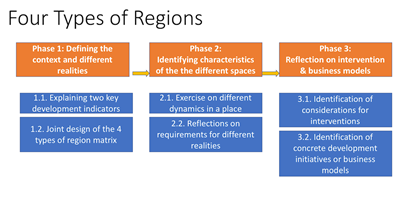
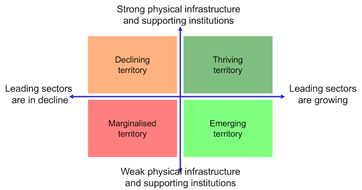
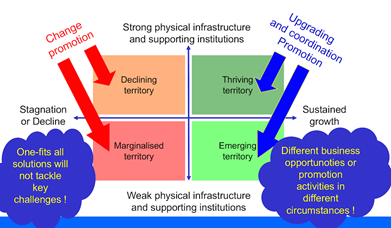
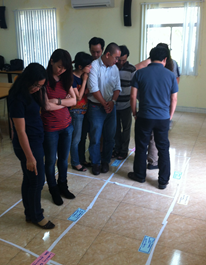
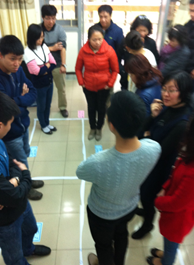
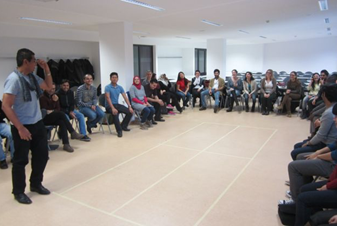
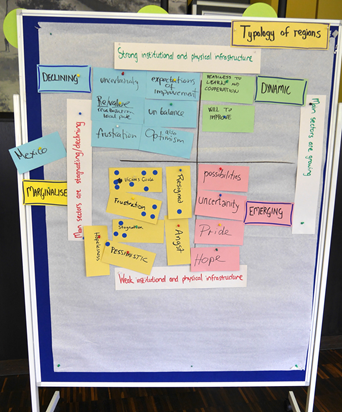
No Comments